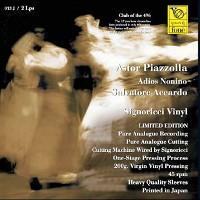Ultimate Analog Applied by Foné to Dramatic Piazzolla Compositions
Written in 1959 to celebrate his father and mark his passing, Astor Piazzolla’s “Adiós Nonino” is a moving, appropriately sentimental work that occasionally veers into melodrama.
The opening piano solo on this orchestral edition arranged by Francesco Fiore for Italian-born violinist/composer/conductor Salvatore Accardo expresses the composer’s profound sadness in stark terms. The orchestra follows, anchored by Mr. Accardo’s weepy violin, behind which the piano reprises the opening pain.
The ten minute piece, which fills all of side one of this double sided, two 45rpm disc set, is cinematic in scope and at the beginning may remind some listeners of Nino Rota’s nostalgic score for Fellini’s “Amarcord.” But the opening sentiment gives way to a violent, almost frightening anguish of Bernard Herrmann proportions, with Accardo ripping the bow across the strings, in long, aggressive strokes. The piece ends by blending the two emotions into a sad and anguished finale.
Replacing the bandoneon with a weepy violin played in the dramatic Italian style gives the piece added pathos and an almost silent-movie musical score sensation.
The album features six other nine minute and under Piazzolla pieces, all of which evoke varying degrees of melancholy, high drama, sadness and occasional whimsy and light-hearted humor anchored by Accardo’s rich, thick, fluid tone. He’s not holding back!
If you like music that paints effortless, highly evocative mind pictures, you’ve come to the right place here, aided by a vivid, spacious, simply miked recording meticulously issued on double 45rpm 200 gram Japanese-pressed vinyl (same plant as the recent UMG titles) using a single step process.
That means that whereas standard pressings go through a double plating process (plate lacquer, plate resulting ridged “negative,” (the father) to produce a grooved “mother,” plate grooved “mother” to produce a ridged “stamper,”) in order to assure maximum production from the original plated lacquer, the single step process plates the lacquer and that resulting ridged “father” is put in the press to produce records.
The “father,” will eventually wear out so no more records can be generated from it. In the conventional “two-step” process, the “mother” can be re-used to produce more stampers and when it wears down, the “father” can be re-used to produce another “mother.” This is why the so-called “hot-stamper” pressings sold for exorbitant prices by the clown Tom Port are such out and out bullshit. The earlier the stamper, the better should be the resulting sound. Later stampers, generated from worn “mothers” will sound soft and lack dynamics. So it’s not so much some mysterious and rare “hot stamper” pressing as much as it is finding a pressing from an early stamper. But even then, if you get the final record pressed from that early stamper, it’s likely to not be as good as the first record pressed from the second stamper and so on.
The real issue is the quality margins allowed by the pressing plant and how often it changes out stampers. In the case of this record, conceived, recorded, produced and mastered by Giulio Cesare Ricci, the larger than life, wonderfully eccentric that only Italy could have produced. Senior Ricci has a special affinity for the number 496 so that’s the number of records that have been pressed of this and his other recent Japanese-pressed vinyl titles. That’s not enough to dull even the stamper’s sharpest etch.
Ricci cut the lacquers on a re-wired lathe that he’d bought from David Manley, along with the metal parts for the series of LPs Manley had issued during the darkest days of analog. Those have been issued as double 45rpm 200g releases as well.
The recording, in Rome’s Pontificio Istituto di Musica Sacra from May 19th-27th 2001, when the world was a brighter, simpler place, features three Neumann tube microphones (U47, U48, U49) fitted with Ricci-designed and built preamplifiers and connected with Ricci-designed mike, line and power cables, feeding a two track Studer C 37 reel to reel recorder. The signal path could hardly have been simpler or purer and combined with the one-step pressing process plus the quiet Japanese vinyl, results in a sonic spectacular, though I think sr. Ricci didn’t quite get a 100 percent holographic image of Accardo’s violin. However, other than that minor quibble, the instrument’s texture and tonality have been beautifully captured, as has the piano along with the orchestral accompaniment and the venue itself. Dynamics are wide-range and believable as well.
This is a truly special double LP set that will be enjoyed by only 496 lucky listeners. You’ll revel in the sound and youl’ll likely to be moved to tears as the music elicits your own personal memories in reaction to the strong emotions Piazzolla brings to the compositions and the musicians wring from the charts. Bravissimo!
- Log in or register to post comments



